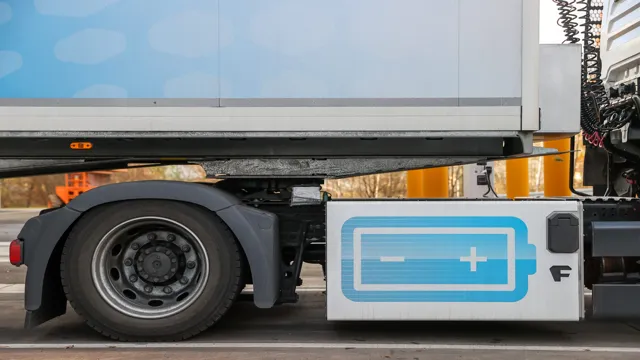The Shocking Truth of Electric Car Battery Discharge Rate: How to Optimize Your Driving
Electric cars are becoming increasingly popular as people are looking for ways to reduce their carbon footprint and save money on gas. However, one of the main concerns that people have about electric cars is their range anxiety, or the fear of running out of battery power. To mitigate this fear, it is essential to understand the concept of electric car battery discharge rate.
Essentially, this refers to the rate at which an electric car battery discharges its energy while in use. Understanding this rate can help drivers plan their trips more effectively and ensure they do not run out of power mid-journey. In this blog post, we explore the factors that influence the discharge rate of electric car batteries, the impact of different driving conditions, and how to increase your electric car’s range.
So, sit back, relax, and let’s explore the fascinating world of electric car batteries.
What is Battery Discharge Rate?
When we talk about electric car batteries, one important thing to consider is its discharge rate. Simply put, the discharge rate refers to how fast the battery will lose its charge. This is typically measured in units known as amperes (A) and is often denoted as “C” rating.
For example, if the battery has a discharge rate of 1C, it will discharge fully in one hour when subjected to a load. A high discharge rate means that the battery will be able to deliver more power, but it will also discharge quickly. On the other hand, a battery with a lower discharge rate will not deliver as much power but will last longer overall.
It’s important to find a balance between power delivery and battery life when selecting an electric car battery, and the discharge rate is a critical part of this decision-making process.
Definition and Basics
Battery discharge rate is a measure of how quickly energy is released from a battery. It is often expressed in terms of amps or milliamps, and is a critical factor in determining how long a battery will last in a given application. A high discharge rate means that a battery can release energy quickly, but may not last as long overall.
Conversely, a low discharge rate means that a battery will last longer, but may not be suitable for high-power applications. It is important to choose a battery with an appropriate discharge rate for your specific needs to ensure that it will perform optimally and meet your requirements. Overall, understanding battery discharge rate is crucial in choosing the right battery for any application.

Factors Affecting Discharge Rate
What is Battery Discharge Rate? Battery discharge rate is the rate at which a battery loses its charge over time. The discharge rate is dependent on various factors, including temperature, usage, charging habits, and the type of battery. For instance, high temperature can cause the battery to lose its charge more quickly, while low temperatures can slow down the discharge rate, making the battery last longer.
Similarly, usage and charging habits can also affect how quickly the battery loses its charge. Frequent use and inadequate charging can cause faster discharge rates, while occasional use and proper charging can preserve battery life. Lastly, the type of battery distinguishes the discharge rate.
Li-ion batteries have a lower self-discharge rate, meaning they can hold their charge for longer periods when not in use compared to lead-acid batteries, which are better suited for situations requiring high bursts of energy.
How is Battery Discharge Rate Measured?
When it comes to measuring the discharge rate of an electric car battery, there are several factors that come into play. The discharge rate is essentially the rate at which the battery loses its charge over time. This is typically measured in amps, and can vary depending on a number of different variables including the type of battery, temperature, and usage patterns.
Manufacturers often provide technical specs that detail the expected discharge rate under different conditions, but in practice, the actual discharge rate can vary quite a bit based on how the car is driven. To get an accurate measurement of the discharge rate, specialized equipment is often used to test the battery under controlled conditions. This can give a better sense of how quickly the battery will drain under different scenarios, which is important for determining the overall range of an electric vehicle.
Overall, understanding the discharge rate is an essential part of owning and operating an electric car, and can help ensure that you’re getting the most out of your battery.
Measurement Tools and Techniques
Battery discharge rate is a crucial metric when it comes to assessing the performance of batteries, and various tools and techniques are used to measure it. One commonly used tool is a digital multimeter, which can measure direct current (DC) voltage and current flowing through the battery. These measurements allow for the calculation of the battery’s discharge rate.
Another technique involves using a load tester, which applies a constant current to the battery and monitors the voltage drop over time. This provides an estimate of the battery’s capacity and discharge rate. Other factors, such as temperature and the battery’s age, can also affect its discharge rate, which makes regular monitoring and maintenance important to ensure optimal battery performance.
Overall, measuring battery discharge rate is essential for determining a battery’s health and predicting its performance under various conditions.
Interpreting Discharge Rate Data
Battery Discharge Rate Measuring battery discharge rate is crucial in evaluating the performance of a battery. The rate at which a battery discharges can vary depending on several factors such as temperature, load, and battery capacity. Typically, discharge rate is measured in Amperes (A) or milli-Amperes (mA) and can be obtained using a multimeter or specialized instruments.
The discharge rate can be affected by the load, which refers to the amount of current drawn from the battery. Higher loads will result in a faster discharge rate, while lower loads will result in a slower rate. It’s important to keep in mind that the discharge rate can also be influenced by external factors such as the battery’s age and condition.
In conclusion, measuring battery discharge rate is necessary to ensure the smooth operation of devices powered by batteries. Understanding the factors that affect discharge rate and monitoring their performance can help determine the battery’s health and optimal usage. Whether you are using batteries for household devices or industrial applications, knowing how to interpret discharge rate data can save you a lot of trouble and money in the long run.
Comparing Discharge Rates of Different Batteries
When comparing discharge rates of different batteries, it’s important to have a clear understanding of how battery discharge rate is measured. Simply put, battery discharge rate is the amount of energy that a battery can deliver in a certain amount of time. This is typically measured in amps or milliamps, with the discharge rate being higher if the battery can deliver more energy in a shorter amount of time.
Several factors can impact a battery’s discharge rate, including the type of battery, its capacity, and the level of use. Higher-capacity batteries often have higher discharge rates, but they may also take longer to recharge. It’s important to consider all of these factors when comparing the discharge rates of different batteries, as a battery’s performance can vary significantly depending on its specifications and usage.
Ultimately, choosing the right battery for your needs requires careful consideration of its discharge rate, capacity, and other features that will impact its overall performance.
Why is Battery Discharge Rate Important for Electric Cars?
When it comes to electric cars, one of the most important factors to consider is the battery discharge rate. This refers to the rate at which the battery loses its charge over time. And why is this so important? Well, for one, it directly affects the driving range of the vehicle.
The faster the battery discharges, the shorter the distance the car can travel on a single charge. This means that a car with a fast discharge rate may not be suitable for long journeys or commutes. Furthermore, the battery discharge rate can also impact the lifespan of the battery itself.
A battery that discharges quickly may need to be replaced sooner than a battery that retains its charge for longer periods of time. As such, it’s important to take the battery discharge rate into account when considering the overall cost and sustainability of an electric car.
Impact on Car Performance and Range
Battery discharge rate is a crucial aspect of electric cars that directly affects their performance and range. Simply put, the more energy that a battery releases at any given time, the quicker it will run down. This means that if a car has a high discharge rate, it may be able to accelerate faster but it will also need to be charged more frequently.
Conversely, a low discharge rate may result in less power but also a longer life span for the battery. Essentially, striking a balance between the two is key. Think of the discharge rate like a runner who sprints versus one who takes their time.
The sprinter may get to the finish line first, but they will also tire out more quickly and need longer rests. On the other hand, the slower runner may take longer but they can also keep up a steady pace for longer periods of time without needing breaks. That’s why finding the right discharge rate is crucial for electric cars to maximize both performance and longevity.
Battery Capacity and Charging Frequency
Battery discharge rate is a crucial factor to consider when it comes to electric cars. The rate at which the battery discharges determines the vehicle’s range, which in turn affects the frequency of charging required. The larger the battery capacity, the longer the range, and the less frequent the need for charging.
However, the battery’s discharge rate also depends on external factors such as driving conditions, temperature, and the use of electronics within the car. It’s essential to strike a balance between the battery capacity and the frequency of charging to ensure optimal performance and convenience for electric car owners. Overall, a careful consideration of the battery discharge rate is critical when evaluating an electric vehicle’s suitability for your needs.
Conclusion
In conclusion, the discharge rate of an electric car battery can be compared to that of a dieting person’s willpower at a dessert buffet. Just as a person may be able to resist temptation for a while, the battery can hold a charge for a certain amount of time. However, eventually both will give in to their urges and deplete their reserves.
The key is to practice self-control and efficiency, whether it be limiting dessert intake or finding ways to conserve battery power. Happy driving and happy dieting! “
FAQs
What is an electric car battery discharge rate?
An electric car battery discharge rate is a measure of how quickly the battery loses its charge while it is being used.
How is the discharge rate of an electric car battery measured?
The discharge rate of an electric car battery is typically measured in terms of its amp-hour rating.
What factors affect the discharge rate of an electric car battery?
The discharge rate of an electric car battery can be affected by a number of factors, including the temperature, the amount of charge in the battery, and the demand being placed on it by the vehicle.
How long does it take for an electric car battery to discharge?
The length of time it takes for an electric car battery to discharge will depend on a number of factors, including the capacity of the battery, the type of usage it is being put to, and the external conditions in which it is being used.




